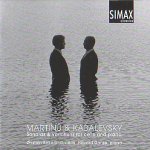Martinu’s three cello sonatas are beefy, passionate works, and in the truncated but highly concentrated first sonata, Øystein Birkeland’s high-adrenaline approach pays off handsomely. Birkeland is a reflective and insightful player, too, and the Lento slow movement is particularly touching in this account. To cite comparison with Christian Benda’s often raw-boned, brittle-sounding Naxos version, which is further undermined by dismal piano sound (its dry, unresonant quality is largely the result of miscalculations on the part of the of the sound engineers), Birkeland is the more disciplined player, driving the music forward powerfully without losing sight of countless dynamic and phrasing subtleties. The net result is a declamatory, forthright reading, with an intellectual rigor that’s often lost in this music. Technically this is quite on the level with–and sometimes, particularly in the finale, superior to–Janos Starker’s 1990 RCA recording with Rudolf Firkušny.
The two Martinu variation sets again bring a pleasing fusion of technical panache and textual resourcefulness, as Birkeland and pianist Hávard Gimse forge a muscular and convincing partnership. The juxtaposition with the Op. 71 Kabalevsky sonata is an interesting one, and the resulting stylistic polarizations have been shrewdly considered by this duo. If there is a caveat here, it would be a minor one: the second movement is a little stiff and mannered at times–Kabalevsky’s addition of the word “rubato” perhaps could have been taken a bit more literally. But the bluff Kabalevsky sonata really isn’t in the same category musically as these intoxicating Martinu pieces, and not even my preferred reading from Antony Elliott (Koch) manages to get much more from the work than do Birkeland and Gimse. Finally, the Simax recording, made in the open acoustic of the Sofienberg Church in Oslo, is very superior, offering high all-round production values.
































